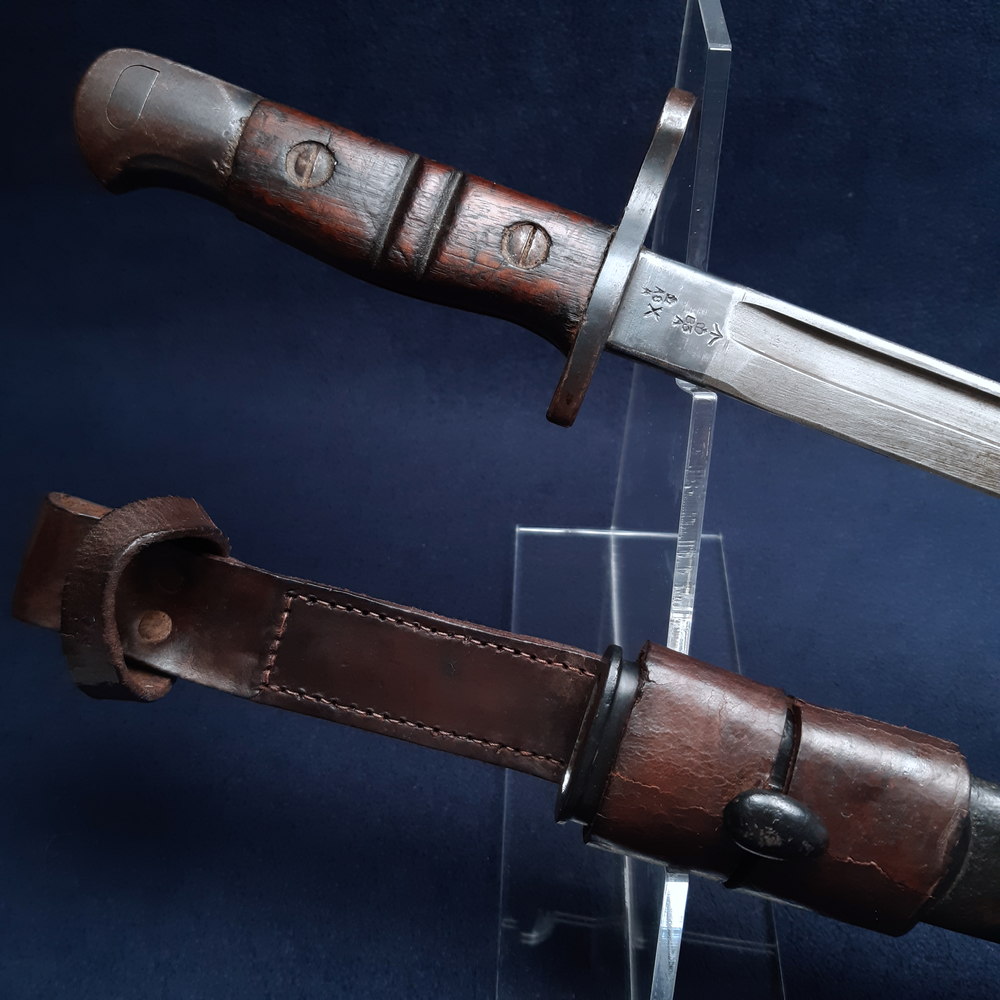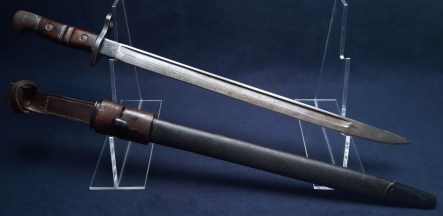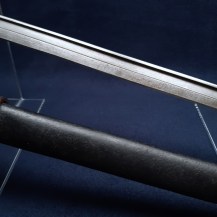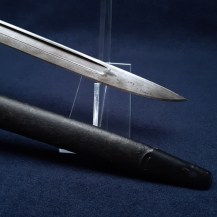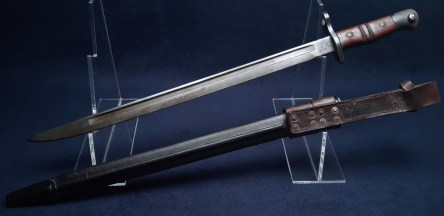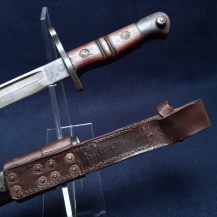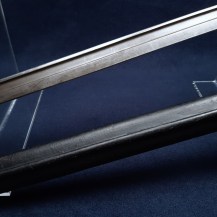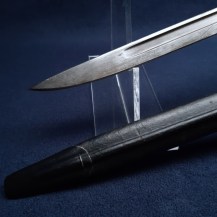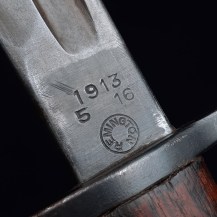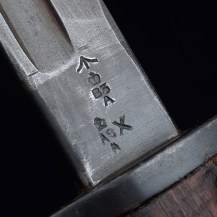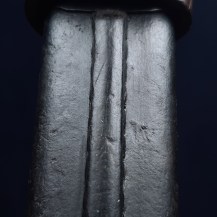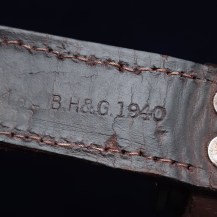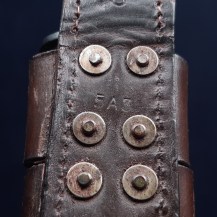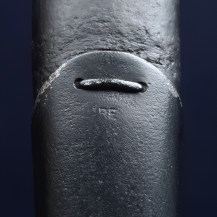British WW1 1913 Pattern Bayonet, Dated 1916 by Remington
Straight single-fullered knife blade, steel hilt with muzzle ring, wood slab grips with characteristic pair of cut grooves on each slab, secured by two screws. Steel beaked pommel and locking button. Brown leather scabbard with steel locket & chape piece, the locket with teardrop frog stud. Brown leather 1938 Pattern leather frog with retaining loop.
The ricasso is stamped on one side with ‘1913 5 16’, indicating that it is the 1913 Pattern, manufactured in May 1916, and the maker’s mark ‘Remington’ within a circle. On the other side it is stamped with a ‘broad arrow’ War Department stores mark, two crown inspection marks with ‘A’ for America and an ‘X’ indicating that it passed a manufacturer’s bending test.
The leather section of the scabbard is stamped next to the seam with a faint ‘W’ which would indicate the scabbard was made with a waxed finish. The frog is stamped on the reverse side with the maker’s mark ‘B. H & G. 1940’, indicating that it was made by the firm of Barrow, Hepburn & Gale in 1940, as well as a broad arrow, ‘25’ and ‘5A3’. The chape piece of the scabbard is stamped with ‘RE’ for Remington.
Inspired by the German Mauser M98 rifle, the experimental Pattern 1913 Enfield was intended to be the next generation British infantry rifle, firing the new .276 cartridge. The outbreak of war curtailed its development and the well-established SMLE was retained in service instead. However with an urgent need for rifles the government opted to redesign the 1913 to take the existing .303 cartridge, calling this new rifle the Pattern 1914 (NB: the bayonet’s design did not require modifications, therefore it remained the ‘1913 Pattern’ bayonet). The production of these rifles and their bayonets was contracted to American manufacturers – an early handful were made by Vickers but it was clear that British plants were best left to make the SMLE.
Remington was the largest manufacturer of the 1914 Pattern and its associated bayonet, producing 1,243,000 of the bayonets between 1916 and 1917. The 1914’s design was vindicated in that it proved to be more accurate than its predecessor and it was deployed principally as a sniper rifle, the Winchester-made rifles in particular thought to be of high quality, suitable for fitting with telescopic sights. It saw service again during WW2 as rear echelon equipment, e.g. with the British Home Guard, although some were again used in a sniper configuration. The distinctive 1938 Pattern frog that has been fitted suggests that this bayonet was issued to the Home Guard during WW2.
The 1913 Pattern should not be confused with the M1917 Enfield, also known as the ‘American Enfield’, which was essentially the same rifle design, this time adopted by the Americans and rechambered in their own .30-06 Springfield cartridge. Its bayonet was also essentially the same as the British model, but with US service marks and a ‘1917’ pattern stamp.
Founded in 1760 as Hepburn and Sons, Barrow, Hepburn & Gale was a manufacturer of leather goods based in the ancient tannery district of Bermondsey, London, which at times supplied the British Army with items such as saddles and bayonet scabbards. During the Second World War its tannery complex at The Grange, Bermondsey, was hit by aerial bombing and its chairman, George Odey, received a CBE for his company’s contribution to the war effort. The firm still trades under the same name, notably manufacturing the red leather dispatch boxes used by government ministers since 1853, and the leather purses used in the 800-year-old tradition of Royal Maundy.
The blade has no edge damage, slight rolling to the tip. The edge is sharp and the tip is undamaged. It retains its original parkerised finish and blued area at the ricasso, with some small spots of patination, and one spot of light pitting at the end of the fuller on one side. The hilt, exposed tang and pommel have a blued finish with rubbing at raised edges. The wood grips have a few small dents. The scabbard fittings have been painted black with only small spots of wear at edges and on the frog stud exposing bright steel. The leather body of the scabbard has only light rubbing and a few small scratches, all of its stitching is intact. The leather frog has some surface-level cracking to the retaining strap and one surface-level crack on the front of the throat loop next to the frog stud. Its leather is a little stiff but in good condition, with all of its stitching intact.

